Acids, Bases & Salts | Famous Books for UPSC Exam (Summary & Tests) PDF Download
Have you ever experienced a burning sensation in your chest or throat after overeating? This discomfort is often caused by excess stomach acid, and it's a common digestive problem known as acidity. But did you know that you can get relief from this discomfort using simple household items like lemon juice, vinegar, or baking soda solution?

The reason why these substances work is because they have acidic or basic properties that can neutralize the excess acid in your stomach. In this chapter, we'll explore the properties of acids, bases, and salts and how they interact with each other.
Understanding The Chemical Properties of Acids And Bases
What is Acid?
It is defined as a chemical compound that has a distinct sour flavour and possesses the property of being acidic. Chemically, it is characterized by a pH value that is less than 7, indicating that it has a higher concentration of hydrogen ions than hydroxide ions.
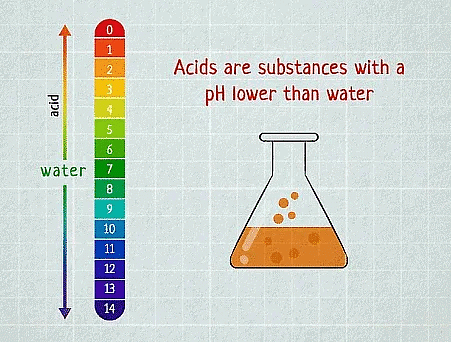 Acid DefinitionExamples:
Acid DefinitionExamples:
- Acetic acid (vinegar)
- Citric acid (lemon juice)
- Lactic acid(milk) and organic acids are hydrochloric acid (HCl)
- Sulphuric acid (H2SO4 )
- Nitric acid (HNO3).
[Question: 793919]
Properties of Acids
Let's understand the properties of acids which are as follows :
- The term ‘acid’ has been derived from the Latin word, 'acidus' which means sour.
- Acids have a sour taste.
- They turn blue litmus solution red.
- They give H+ ions in an aqueous solution.
Categories of Acids
(i) Strong Acids: An acid, which dissociates completely or almost completely in water are strong acids. Examples: HCl, H2SO4, and HNO3.
(ii) Weak Acids: Acid that dissociates only partially when dissolved in water are weak acids. Examples: CH3COOH, Oxalic acid, and Lactic acid.
(iii) Concentrated Acids: A concentrated solution is a liquid with a high solute concentration. A dilute solution is a liquid having a lower solute content. (More amount of acid + Less amount of water).
(iv) Dilute Acids: A dilute solution is a liquid having a lower solute content. (More amount of water + Less amount of acid).
What is
Base?
A chemical compound that has a distinct bitter taste and possesses the property of being basic is defined as a base. Chemically, it is characterized by a pH value that is more than 7, indicating that it has a higher concentration of hydroxide ions than hydrogen ions. Bases are often slippery to the touch and are typically found in cleaning products, soaps, and many other industrial and household applications.
Examples:
- Sodium hydroxide (NaOH)
- Calcium hydroxide [Ca(OH)2]
- Potassium hydroxide (KOH).
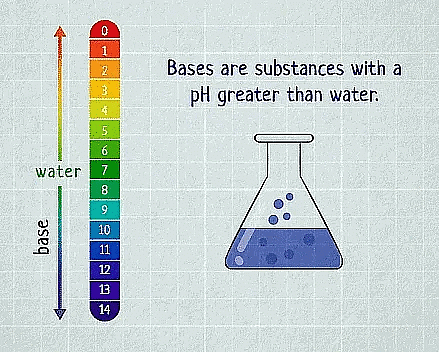 Base Definition
Base Definition
Properties of Bases
- These are the substances that are bitter in taste and soapy in touch.
- They turn red litmus solution blue.
- They give OH- ions in an aqueous solution.
Categories of Bases
These are as follows:
(i) Strong Bases: Strong bases are those which ionize in water completely and produce a large number of hydroxide ions. Weak bases are those bases that partially ionize in water and produce a little number of hydroxide ions.
Example: NaOH, KOH, Ca(OH)2
(ii) Weak Bases: Weak bases are those bases that partially ionize in water and produce a little amount of hydroxide ions.
Example: NH4OH
(iii) Alkalis: These are bases that are soluble in water.
Example: NaOH, KOH, Ca(OH)2.
[Question: 786026]
How do Acids and Bases React with Metals?
In general, acids react with metals to give salt and release hydrogen gas. In general, bases do not react with metals and release hydrogen gas.
Here are some reactions :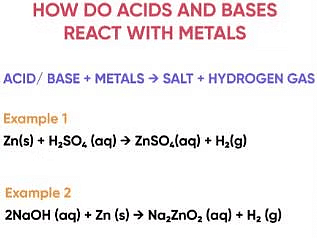
(a) Reaction of Acids with Metals
When an acid reacts with a metal, the metal undergoes a displacement reaction, where it displaces hydrogen from the acid. This results in the formation of a salt and hydrogen gas.
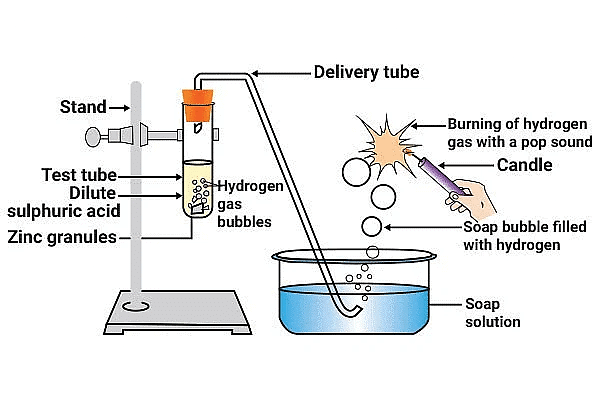 Reaction of Acids with Metals
Reaction of Acids with Metals
Equations like
Acid + Metal → Salt + Hydrogen Gas
Example: Zinc granules react with dilute Hydrochloric acid in a test tube.
HCl + Zn → ZnCl2 + H2
(b) Reaction of Bases with Metals
Bases react with the metal to evolve hydrogen Gas. Also, note that all metals do not react with bases. The metal must be more reactive than the metals present in the base for the reaction to take place.
Equations like
Base + Metal → Salt + Hydrogen gas
Example: Zinc granules react with NaOH solution to form sodium zincate and evolve hydrogen gas.
2NaOH + Zn → Na2ZnO2 + H2
Note: Hydrogen gas released can be tested by bringing burning candle near gas bubbles, it burst with pop sound.
How do Metal Carbonates and Metal Hydrogencarbonates React with Acids?

- Acids react with Metal Carbonates and Metal Hydrogen carbonates to form Salt, Carbon dioxide and water.
- Reaction: Metal carbonate/Metal hydrogen carbonate + Acid → Salt + Carbon dioxide + Water.
Examples:
(i) 2HCl + Na2CO3 → 2NaCl + CO2 + H2O
(ii) HCl + NaHCO3 → NaCl + CO2 + H2O - CO2 can be tested by passing it through lime water. It turns lime water milky.
Ca(OH)2 + CO2 → CaCO3 + H2O - When excess CO2 is passed, milkiness disappears.
CaCO3 + CO2 + H2O → Ca(HCO)3 - Bases do not react with Metal Carbonates and Metal Hydrogen carbonates.
Base + Metal Carbonate/Metal Hydrogen Carbonate → No Reaction
How do Acids and Bases React with each other?
The reaction between an acid and a base is known as a neutralization reaction. When an acid and a base are mixed together, they react to form a salt and water.

Reactions:
- Acids and Bases react to form salt and water.
Acid + Base → Salt + H2O - Neutralisation Reaction: Reaction of acid with a base is called a neutralization reaction.
Example: HCl + NaOH → NaCl + H2O
Some more Reactions:
- Strong Acid + Weak Base → Acidic salt + H2O
- Weak Acid + Strong Base → Basic salt + H2O
- Strong Acid + Strong Base → Neutral salt + H2O
- Weak Acid + Weak Base → Neutral salt + H2O
Note:The pH of the resulting solution depends on the strength of the acid and base used. If the acid is strong and the base is weak, the resulting solution will be acidic. If the base is strong and the acid i
s weak, the resulting solution will be basic. If both the acid and base are equally strong or weak, the resulting solution will be neutral.
[Question: 793920]
Reaction of Metallic Oxides with Acids & Bases
(i) Reaction of Metallic Oxides with Acids
When a metallic oxide reacts with an acid, it typically produces salt and water.
The general chemical equation for this type of reaction is :
Metallic oxide + Acid → Salt + Water
Example: When calcium oxide (CaO) reacts with hydrochloric acid (HCl), it produces calcium chloride (CaCl2) and water (H2O):
CaO + 2HCl → CaCl2 + H2O
(ii) Reaction of Metallic Oxides with Bases
Metallic oxides are also basic in nature.
Example: CaO and MgO are basic oxides.
Metallic Oxide + Acid → Salt + H2O
CaO + 2HCl → CaCl2 + H2O
Reaction of Non-metallic Oxides with Bases
Non-metallic oxides are acidic and react with bases to form salt and water. The general chemical equation for the reaction between a non-metallic oxide and a base is:
Non-metallic oxide + Base → Salt + Water
The reaction between sulfur dioxide (SO2) and sodium hydroxide (NaOH):
SO2 + 2NaOH → Na2SO3+ H2O
- Non-metallic oxides are acidic in nature.
- Non-metallic Oxide + Base → Salt + H2O
CO2 + Ca(OH)2 → CaCO3 + H2O
Some Reactions of Acid:
(i) Acid + Metal Carbonate → Salt + CO2 + Water
(ii) Acid + Metal → Salt + H2
(iii) Acid + Metal Hydrogen Carbonate → Salt + CO2 + H2O
(iv) Acid + Metallic oxide → Salt +H2O
(v) Acid + Base → Salt + H2O
Some Reaction Of Base:
(i) Base + Metal → Salt + H2
(ii) Base + Metal Carbonate → No Reaction
(iii) Base + Metal Hydrogen Carbonate → No Reaction
(iv) Base + Acid → Salt + H2O
(v) Base + Non Metallic oxide → Salt + H2O
What Do All Acids And All Bases Have In Common?
Acids and bases are two types of substances that have different chemical properties. However, they do share some similarities:
- Both acids and bases can be classified as electrolytes. This means that they can conduct electricity when dissolved in water.
- Acids and bases can react with each other to form salts and water. This reaction is called a neutralization reaction.
- Acids and bases can change the colour of certain indicators. For example, acids turn litmus paper from blue to red, while bases turn it from red to blue.
- Both acids and bases can be strong or weak. The strength of an acid or base depends on how many hydrogen ions (H+) or hydroxide ions (OH-) it produces when dissolved in water.
- Acids and bases are important in many chemical reactions. For example, acids are used in batteries, while bases are used in cleaning agents.
[Question: 786057]
What Happens to an Acid or a Base in a Water Solution?
- Acids produce H+ ions in the presence of water.
- H+ ions cannot exist alone, they exist as H3O+ (hydronium ions).
H+ + H2O → H3O+
HCl + H2O → H3O+ + Cl- - Bases when dissolved in water give OH− ions.
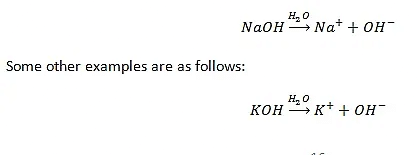
- Bases soluble in water are called alkali.
- While diluting acids, it is recommended that the acid should be added to water and not water to acid because the process of dissolving an acid or a base in water is highly exothermic.
How Strong Are Acid Or Base Solutions?
- Strength of an acid or base can be estimated using a universal indicator.
- Universal indicator: It is a mixture of several indicators. It shows different colours at different concentrations of H+ ions in the solution.
- pH Scale: A scale for measuring H+ ion concentration in a solution. p in pH stands for ‘potenz’ a German word which means power.
- If the value of ph is equal to 7 → neutral solution
- If the value of pH is less than 7 → acidic solution
- If the value of pH is more than 7 → basic solution
Indicators and the Types of Indicators
Substances which change their colour/smell in different types of substances (like acids and bases).
Types of Indicators
- Natural indicators
- Synthetic indicators
- Olfactory indicators
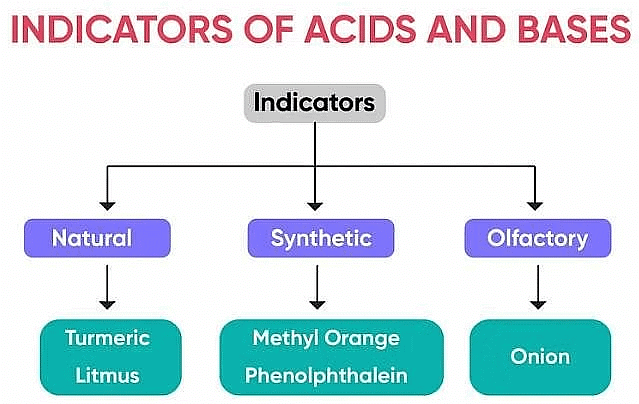 Indicators of Acids and Bases
Indicators of Acids and Bases
1. Natural Indicators: Indicators that are originally Found in nature in plants.
Example: Litmus, red cabbage leaves extract, flowers of hydrangea plant, turmeric.
Diagrammatically: Naturals Indicators2. Synthetic Indicators: Synthetic indicators are man-made substances that are used to determine the pH (acidity or basicity) of a solution.
Naturals Indicators2. Synthetic Indicators: Synthetic indicators are man-made substances that are used to determine the pH (acidity or basicity) of a solution.
Example: Methyl orange, and phenolphthalein.
(a) Methyl orange: a popular pH indicator that is used in titration.
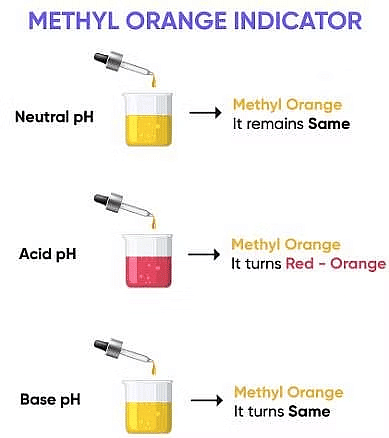 Methyl Orange Indicators
Methyl Orange Indicators
(b) Phenolphthalein: a synthetic indicator that is often used in labs to test the pH of a solution. It is colourless in neutral solutions but turns pink or red when added to a basic solution.
 Phenolphthalein3. Olfactory indicators: Those substances whose smell or odour changes when mixed in an acidic or basic solution. It can be used in the laboratory to test whether the solution is base or acid and perform an olfactory titration.
Phenolphthalein3. Olfactory indicators: Those substances whose smell or odour changes when mixed in an acidic or basic solution. It can be used in the laboratory to test whether the solution is base or acid and perform an olfactory titration.
Example: onion, clove oil and vanilla extract.
[Question: 781965]
Importance of pH in Everyday Life
- Sensitivity of plants and animals: The pH level has a significant impact on both plants and animals. Many important biological processes, including enzyme and hormone activity as well as digestion, require a specific pH range to function properly. This means that even slight changes in pH can have a major impact on the overall health and well-being of living organisms.
- Soil: The ideal pH range for soil to support plant or crop growth is between 6.5 and 7.0.
- Digestive system: During the digestion process in our stomach, a particular pH range of 1.5 to 4 is required for optimal digestion to occur. The pH level of the enzymatic reactions that aid in the breakdown of food is affected by the presence of hydrochloric acid (HCl) in the stomach.
- Tooth decay: When the pH of the environment surrounding the teeth drops to 5.5 or lower, tooth decay can occur.
- Self-defence by animals and plants: Acidic substances are used by animals and plants as a self-defence mechanism. For example, bees and plants like nettle secrete a highly acidic substance for self-defence. These secreted acidic substances have a specific pH.
More About Salts
It is defined as a substance that is odourless, salty in taste and soluble in water. Its pH value is equal to 7.
Examples:
- Sodium Chloride (NaCl) - It is commonly known as table salt.
- Epsom Salt (MgSO 4 ) - It is used as a bath salt.
Family of Salts
When salts have either the same cation or anion, they are categorized as members of the same family. For instance, salts like NaCl, KCl, and LiCl would be considered part of the same family because they have the same anion, which is chloride (Cl-). This concept of categorizing salts based on their shared cations or anions is important in chemistry and helps simplify the study of different salts.
pH of Salts
- When a strong acid and a strong base combine to form a salt, the resulting compound will have a neutral pH of approximately 7.
- If a weak acid and a strong base combine to form a salt, the resulting compound will be basic with a pH greater than 7.
- Conversely, if a strong acid and a weak base combine to form a salt, the resulting compound will be acidic with a pH less than 7.
- The pH of a salt formed by a weak acid and a weak base cannot be predicted and must be determined through a pH test.
Chemicals from Common Salt
Commonly known as salt, sodium chloride has a molecular formula of NaCl and is a fundamental element in our diet. It serves as a flavour enhancer and preservative in many of the foods we consume. From salt, it is possible to create four distinct compounds.
- Sodium hydroxide or lye or caustic soda
- Bleaching powder or calcium hypochlorite
- Baking soda or sodium hydrogen carbonate, or sodium bicarbonate
- Washing soda or sodium carbonate decahydrate
1. Sodium Hydroxide
When electricity is passed through an aqueous solution of sodium chloride (called brine), it decomposes to form sodium hydroxide. The process is called the chlor-alkali process because of the products formed– chlor for chlorine and alkali for sodium hydroxide.
2NaCl(aq) + 2H2O(l) → 2NaOH(aq) + Cl2 (g) + H2 (g)

Electrolysis of brine (solution of common salt, NaCl) is carried out.
At anode: Cl2 is released
At cathode: H2 is released
Sodium hydroxide remains in the solution.
2. Bleaching Powder
Bleaching powder, which is produced by reacting chlorine gas with dry slaked lime (Ca(OH)2), is a water-soluble compound commonly used as a bleaching agent in the textile industry, as well as an oxidizing agent and disinfectant in various other industries. It should be noted that its primary use is as a bleaching agent, and it is made by a chemical reaction involving chlorine gas and Ca(OH)2.
Chemical formula – Ca(OCl)Cl or CaOCl2
Preparation – Ca(OH)2(aq)+Cl2(g)→CaOCl2(aq)+H2O(l)
Uses of Bleaching Powder
- It finds application in the laundry for whitening soiled clothes and in the textile industry for bleaching cotton and linen due to its bleaching properties.
- Due to its strong oxidizing abilities, it serves as an oxidizer in several industries.
- It is utilized as a disinfectant to make water potable by eliminating harmful microorganisms.
3. Baking Soda
Sodium bicarbonate, also referred to as baking soda or bicarbonate of soda, is a type of chemical compound represented by the formula NaHCO3 and named sodium hydrogen carbonate by IUPAC. This compound is formed by the combination of a sodium cation (Na+) and a bicarbonate anion (HCO3). Typically, sodium bicarbonate appears as a fine white powder with a slightly salty and alkaline taste, similar to sodium carbonate or washing soda.
NaCl + H2O + CO + NH3 → NH4 Cl + NaHCO3
Chemical formula – NaHCO3
When it is heated during cooking: 2NaHCO3 → Na2CO3 + H2O+CO2
Uses of Baking Soda
- It can lower the level of acidity in the stomach.
- It is utilized as an antacid to manage indigestion and stomach discomfort.
- It is employed as a water softener during the washing process.
4. Washing Soda
Sodium carbonate, also known as washing soda, is another chemical that can be derived from sodium chloride. As mentioned earlier, baking soda can be heated to produce sodium carbonate, which can then be recrystallized to yield washing soda in its hydrated form Na2CO3.10H2O. Similar to sodium carbonate, washing soda is also a basic salt with alkaline properties.
Na2CO3 + H2O → Na2CO3.10H2O
Uses of Washing Soda
- It finds applications in the glass, soap, and paper industries.
- The compound is utilized in the production of other sodium compounds like borax.
- Sodium carbonate serves as a cleaning agent for household use.
- It is employed to eliminate the problem of permanent water hardness.
Crystals of Salts
When certain salts combine with a specific amount of water, they can form crystals. The water that combines with the salt is known as water of crystallization. Crystallization is the process in which a solid substance is formed, where the atoms or molecules are arranged in a strong structure called a crystal. This can occur through precipitation from a solution, freezing, or sometimes by direct deposition from a gas.
 Salt Crystals
Salt Crystals
Example: Table salt, also known as sodium chloride or halite crystals, sugar in the form of sucrose, and snowflakes are all familiar examples of materials that have crystalline structures. Similarly, numerous precious and semi-precious gemstones, including diamond and quartz, are classified as crystals due to their well-defined internal arrangement of atoms or molecules.
[Question: 793923]
Plaster of Paris
Plaster of Paris is a commonly used chemical compound that finds wide application in sculpting materials and gauze bandages. It is essentially a white powder consisting of hydrated calcium sulfate, which is obtained by calcining gypsum. Although we encounter Plaster of Paris frequently in our daily lives, its chemical composition can be described as hydrated calcium sulfate, which is derived from gypsum that has been subjected to high temperatures during manufacturing.

Gypsum plaster and the Plaster of Paris are essentially the same thing. The chemical formula for Plaster of Paris is CaSO4. ½ H2O. If gypsum (CaSO4.2H2O (s)) is heated to a temperature of 100°C (373K), it undergoes a reaction that yields CaSO4. ½ H2O and 3/2 H2O. Plaster of Paris is formed when the compound CaSO4. ½ H2O is produced. The chemical formula for this compound indicates that two units of CaSO4 share one molecule of water.
Uses of Plaster of Paris
- Medical casting: Plaster of Paris is often used in orthopaedic medicine to create casts for broken bones. When mixed with water, it forms a paste that can be moulded into the desired shape around the injured area. The plaster then hardens to create a sturdy cast that helps support the bone as it heals.
Use of Plaster of Paris
- Sculpting and art: Plaster of Paris is a popular material in sculpting and art. It can be moulded into various shapes and textures and dries quickly, making it a convenient choice for creating intricate designs. Artists often use it to make casts, masks, and other decorative pieces.
- Home decoration: Plaster of Paris is also used for home decoration. It can be used to create decorative wall accents, ceiling tiles, and other architectural details. Plaster of Paris can also be used to make decorative figurines, ornaments, and other crafts. Its versatility and ease of use make it a popular choice for DIY projects.
Frequently Asked Questions (FAQs)
Q1. What is an acid?
Ans. An acid is a chemical substance that donates hydrogen ions (H+) or protons in a chemical reaction. Acids have a pH less than 7 and taste sour. Examples of acids are hydrochloric acid, sulfuric acid, and acetic acid.
Q2. What is a base?
Ans. A base is a chemical substance that accepts hydrogen ions (H+) or donates hydroxide ions (OH-) in a chemical reaction. Bases have a pH greater than 7 and taste bitter. Examples of bases are sodium hydroxide, potassium hydroxide, and calcium hydroxide.
Q3. What is a salt?
Ans. A salt is a chemical compound formed when an acid reacts with a base. It is made up of ions, which are formed when the acid and base neutralize each other. The most common salt is sodium chloride (table salt), which is formed when hydrochloric acid reacts with sodium hydroxide.
Q4. What is the pH scale?
Ans. The pH scale is a measure of the acidity or basicity of a solution. It ranges from 0 to 14, with 0 being the most acidic, 7 being neutral, and 14 being the most basic. The pH scale is logarithmic, which means that a change of one pH unit represents a ten-fold change in acidity or basicity.
Q5. What are some common uses of acids, bases, and salts?
Ans. Acids are commonly used in the production of fertilizers, dyes, and plastics. They are also used in the food industry to give tartness to certain foods. Bases are used in the production of soaps, detergents, and cleaning products. They are also used in agriculture to neutralize acidic soil. Salts are used in the food industry as preservatives and flavor enhancers. They are also used in the production of glass, ceramics, and metallurgy.
|
744 videos|1444 docs|633 tests
|





















